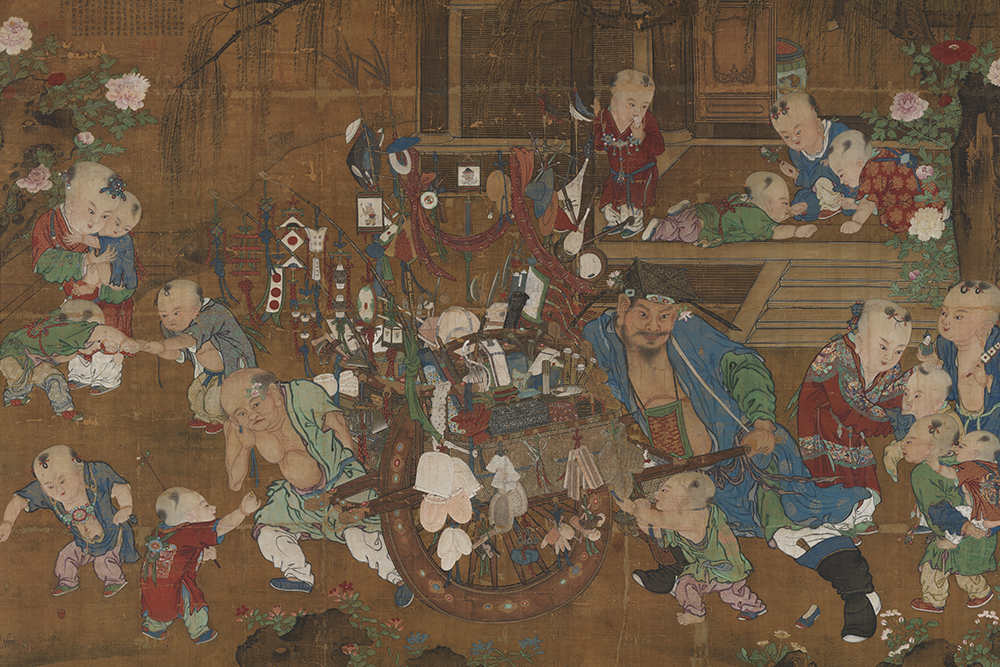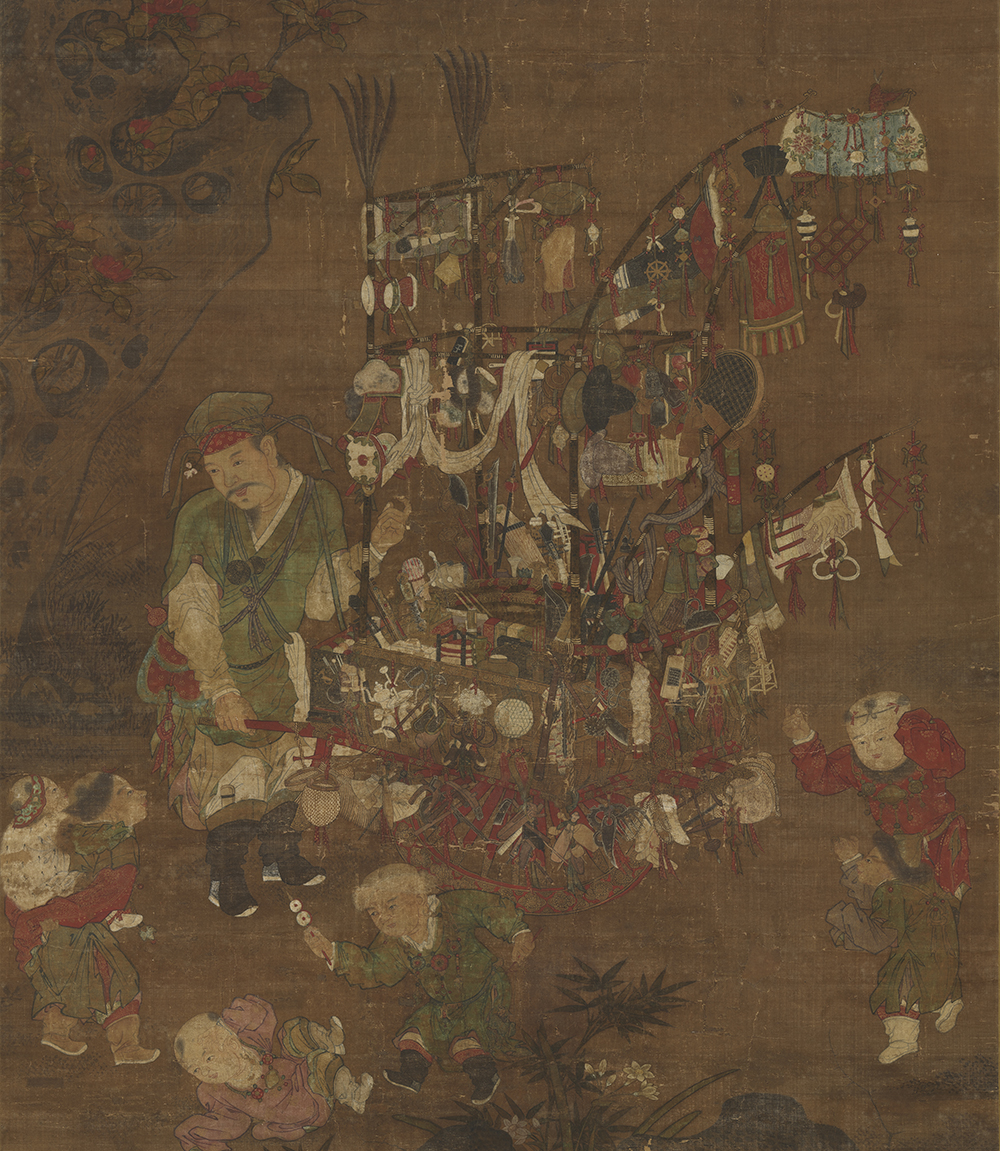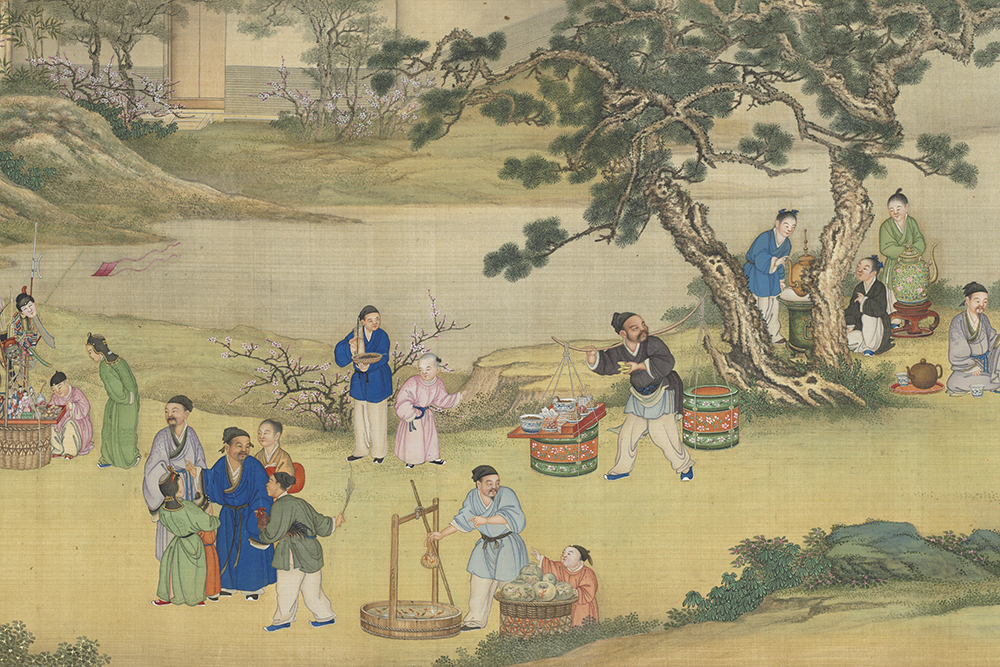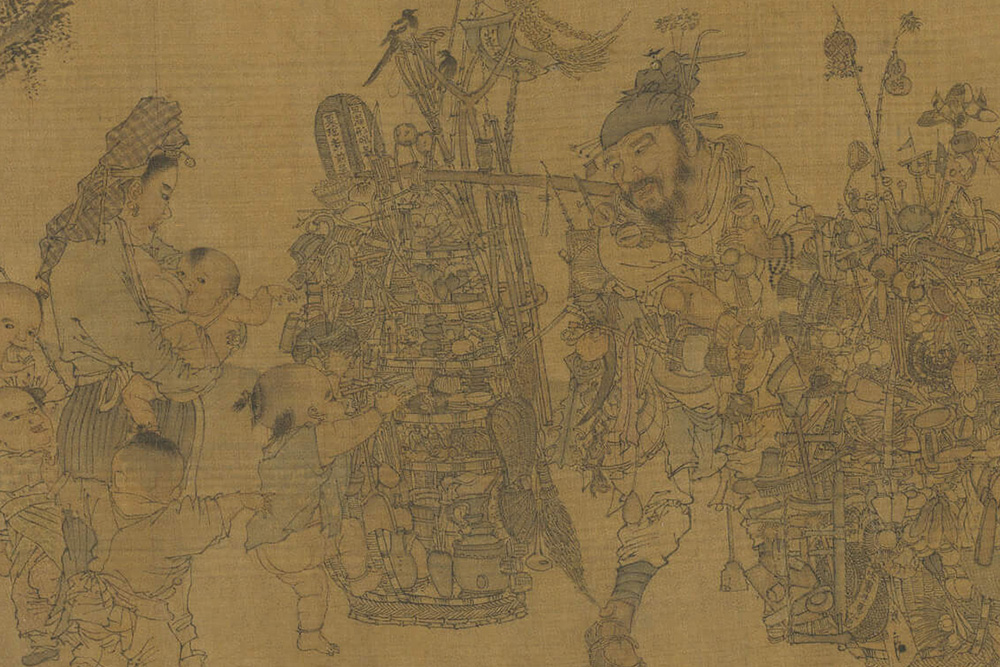Introduction
Knick-knack peddlers were traveling salesmen for sundries in the old days. They would carry assorted goods on a pole slung over their shoulder or in a push cart as they made the rounds in countryside villages, often playing a hand-held pellet drum to announce their arrival. Repeating their melodious or catchy tune, peddlers would advertise wares and describe them in detail, including their functions. Striving to make a sale, peddlers apparently attracted the attention mainly of women and especially children.
The knick-knack peddler brought with him a multilevel arrangement of goods in almost every imaginable type, similar to a miniature supermarket or department store. Besides items for everyday use, there were toys, cosmetics, and even farming tools. Furthermore, he carried sweets and vegetables for sale, having something for everyone in the village, much like a portable store to satisfy both young and old. The attention-getting tune of the knick-knack peddler must have been a common sound and welcome joy in the often-mundane life of country folks in the past.
This exhibition not only presents a variety of paintings depicting knick-knack peddlers from ancient times, the dazzling variety of goods depicted in them also serves as a reminder for older viewers in Taiwan of the "itinerant peddlers of household goods" who plied their trade decades ago. This display is divided into two sections, one for "Gems of Painting: Knick-knack Peddlers over the Ages" and the other especially devoted to "A National Treasure: Li Song's ‘Knick-knack Peddler."
The former introduces the diversity of pictures on knack-knack peddlers from the Song, Yuan, Ming and Qing dynasties, while the latter focuses on the famous "Knick-knack Peddler" painting by Li Song (1170-1255) of the Southern Song period. By illuminating the world of knick-knack peddlers in the past, it is hoped that the richness of these ancient paintings and their cultural perspectives can recreate a dialogue between art and life that allows the museum to further enrich the daily life of modern audiences.
Gems of Painting: Knick-knack Peddlers over the Ages
In Song dynasty painting, attention to naturalism and local customs were emphasized, as exemplified by the appearance of knick-knack peddlers in art at this time. When children heard the peddler's sales pitch, they would rush ahead in the paintings to the wares he brought and shout with delight. With his oft-wrinkled face worn from plying his trade over time and in the elements, the peddler is happy to greet them despite the sweat on his brow.
Paintings of knick-knack peddlers reached a peak in popularity during the Ming dynasty, and even palace versions appeared with peddlers selling "birds in cages" and "wares on a pole beneath blossoms." Although the figures and compositions in paintings from this time are more beautified, the artists' attention to detail is still everywhere to be seen, reflecting both the customs and features of the period.
Palace versions of knick-knack peddler paintings continued into the following Qing dynasty. The peddler's repertoire of wares expanded then to also include colorful lamps, fresh fruits, child figurines, and birds, coming to symbolize as a whole a time of peace and prosperity.
The Knick-Knack Peddler
- Attributed to Su Hanchen (12th c.), Song dynasty
A knick-knack peddler and his assistant are pulling a one-wheel cart laden with all sorts of objects and have arrived at a courtyard. Young children scramble about and cannot wait to get and play with the toys. One eagerly brings coins, another has lost his shoe in the rush, and two are fighting over a toy neither wants to give up. Raucous sounds and actions fill the scenery that has been remarkably rendered true to life, representing a joyous and happy mood that harks the arrival of the knick-knack peddler.
Many kinds of toys, play weapons, musical instruments, lacquer boxes inlaid with mother of pearl, daily sundries, and scented pouch trinkets are found among the peddler's goods; it seems that not a thing is missing. The children wear fancy clothing and are adorned with longevity and jade pendants that are all exquisitely rendered.
The Knick-Knack Peddler
- Attributed to Su Hanchen (12th c.), Song dynasty
The knick-knack peddler in this painting is seen pushing a one-wheel cart full of various sundry items and toys, having come to a stop below camellia and plum blossoms by a large garden rock. Six children have heard the peddler playing his pellet drum and calling out his presence, and they scramble to reach him and crowd around to buy something. The man has one hand on the handle of the cart and in the other peddles a toy, his actions appearing quite dramatic.
The peddler's cart is painted in cinnabar red, and the wheel is adorned with auspicious decoration traced in gold. The children are wearing bracelets, longevity lockets, and opulent clothing that further fill the painting with an air of wealth and prosperity. The delicate painting style follows in the academic tradition of the twelfth-century court painter Su Hanchen.
New Year's Market in a Time of Peace
- Ding Guanpeng (fl. 1708-1771), Qing dynasty
Ding Guanpeng entered the Qing dynasty court as a painter in the Yongzheng reign (1722-1735).
This handscroll depicts the raucous scenery of an urban market during the Lunar New Year season. In addition to all kinds of vendors, there are peddlers with carriers on poles filled with goods plying the pathways and calling out what they have for sale. They are shown selling fresh fruits with two round connected containers of food on a pole. On top of one side is a board, on which are placed various fruits, foods, and dishes. Another peddler is shown with a bamboo carrier, his wares put on display and including various play weapons and masks to attract the children to come, look, and choose from. This is a representative example of the knick-knack peddler as seen in the Qing dynasty.
A National Treasure: Li Song's "Knick-knack Peddler"
National Treasure
"Knick-knack Peddler," Li Song (1070-1155), Song dynasty
Verified and declared by the Ministry of Culture on 24 December 2008
Reasons for designation:
This painting describing a peddler selling his goods in a countryside setting integrates the themes of the knick-knack peddler and children playing. The lines in the brushwork are taut and powerful with numerous objects detailed but not chaotic, being as they are painted in a refined yet dynamic manner. Not only does the painting demonstrate exceptional artistic skills, the lively and naturalistic description of the figures reveals the interest in and concern of the artist towards figures in the countryside.
"Knick-knack Peddler" represents an important achievement of the Painting Academy in the Southern Song dynasty and has exceptional historic significance and period features. It fulfills the requirements in Paragraphs 1, 3, 4, and 6 in Item 1 of Article 1 in the "Regulations Governing the Review of Classification, Designation and Revocation of Antiquities" for designation as a "National Treasure".
Knick-knack Peddler
- Li Song (1070-1155), Song dynasty
- Verified and declared by the Ministry of Culture in December 2008 as a National Treasure
Li Song (1170-1255), a native of Qiantang (modern Hangzhou), served as a Painter-in-Attendance in the Painting Academy at the Southern Song court under three emperors: Guangzong, Ningzong, and Lizong, who reigned from 1190 to 1264. Li Song is said to have specialized in Buddhist and Daoist subject matter, figures, and "ruled-line" painting.
This work depicts an elderly knick-knack peddler holding a pellet drum and accompanied by a shoulder pole carrying his countless wares. He has come to rest by a willow tree somewhere in a countryside setting as a woman with children arrive and swarm around him. The peddler is busy keeping an eye on the mischievous children, having a look of nervousness and hopelessness at keeping the children from his goods. The mother looks down at the items and appears to be lost in thought, the children clamoring with frenzied action and spirit. Along with its realistic details, this painting reveals the children's psychological state of excitement and desire, making it a superb example of Southern Song naturalism.
Exhibit List
| Title | Artist | Period |
|---|---|---|
| Knick-knack Peddler | Li Song (1070-1155) | Song dynasty |
| Knick-knack Peddlers in Spring | Anonymous | Yuan dynasty (1279-1368) |
| The Knick-knack Peddler | Attributed to Su Hanchen (12th c.) | Song dynasty |
| The Knick-Knack Peddler | Attributed to Su Hanchen (12th c.) | Song dynasty |
| A Knick-knack Peddler | Attributed to Su Hanchen (12th c.) | Song dynasty |
| The Knick-knack Peddler and Playing Children | Attributed to Su Hanchen (12th c.) | Song dynasty |
| Child at Play on a Path by a Willow | Attributed to Su Hanchen (12th c.) | Song dynasty |
| Knick-knack Peddler with New Year's Goods | Attributed to Su Hanchen (12th c.) | Song dynasty |
| An Entertainer and Children | Attributed to Su Hanchen (12th c.) | Song dynasty |
| The Knick-knack Peddler | Attributed as anonymous | Song dynasty |
| Painting of a Knick-knack Peddler | Attributed to Qian Xuan (ca. 1235-1303) | Song dynasty |
| The Knick-knack Peddler | Anonymous | |
| Peaceful Start for the New Year | Ding Guanpeng (ca. 1708-1771) | Qing dynasty |
| New Year's Market in a Time of Peace | Ding Guanpeng (fl. 1708-1771) | Qing dynasty |
| Up the River During Qingming | Shen Yuan (18th c.) | Qing dynasty |
















